Higher Degrees, Higher Devotion? Analyzing Religion by Education and Race
Educated people are in the pews, but it does vary by race
The For the Good of the Public Summit, hosted by the Center for Christianity and Public Life, gathers public service-minded leaders (policymakers, nonprofit leaders, pastors, academics, journalists and others) who want to think deeply and work practically for the health of our public life—leaders who believe Christianity offers essential contributions for the good of our neighbors, our institutions, and our shared future. At this event, we consider carefully curated conversations that lead to practical action: how to know and care for our neighbors, build stronger neighborhoods, fight poverty, pursue justice, and influence policy.
This year’s summit will be held October 20–21, 2025, in Washington, D.C., featuring speakers like Gov. John Kasich, Freya India, Joshua DuBois, Richard Reeves, Jonathan Eig, Meghan Sullivan, and Justin Giboney. Learn more and register at: www.ccpubliclife.org/summit. As a subscriber to this newsletter, use the code “SUMMIT20” to get 20% off your ticket.
One of the biggest limitations of the kind of work I do is that it’s often at the aggregate level. In layman’s terms, that’s when I use every respondent in a survey sample. So when I say things like “older people tend to be more religious than younger people” or “women tend to be more likely to go to church than men” - that’s a statement based on analysis where no one is filtered out.
But the underlying statistical reality is that I am talking predominantly about white respondents. The reason for this is simple - most American adults are white. In the 2024 Cooperative Election Study, it’s about 68% of all respondents. So aggregate level analysis may be obfuscating the fact that some relationships that appear at the top level don’t persist when the data is limited to just African-Americans or Asian-Americans.
Let's Have a Talk About Education and Religious Attendance
Here’s why I started this Substack - to allow me to fully expand on some graphs that I post on social media that get all kinds of backlash. That’s exactly what happened a couple of days ago when I posted the graph that’s below.
Let me show you a graph that really kicked off this entire analysis - it’s one that I’ve written about quite a bit on this newsletter. It’s really, really simple. It’s the share of people who identify as atheist, agnostic, or nothing in particular (the nones) by level of educational attainment. Whenever I post it on social media, it always causes quite a stir.
The interpretation is pretty simple, really. Folks who didn’t finish high school are the most likely to identify as non-religious (39%). Among those who went a bit further in their education, about 35% are atheists, agnostics, or nothing in particular. For those who finished a four-year degree, one third are non-religious and it drops even lower for those who have taken coursework at the graduate level – just 31% are nones.
The upshot of this is simple and counterintuitive for many: there’s no empirical evidence that educated people are more likely to flee religious affiliation. Actually, there’s a slight negative relationship in this data. Those with the most education are the least likely to identify as atheist, agnostic, or nothing in particular.
But remember - this data is at the top level. So maybe what’s happening is that this overall relationship is negative for white people but it may be positive for Black, Hispanic, or Asian respondents. I just wanted to explore that possibility in the rest of the post today.
To do that, I repeated the same analysis from the prior graph but I broke the sample down into five different racial groups. (I also combined the last four years of the CES so that I would have a really robust sample size).
The results for the white-only sample look a whole lot like the first graph from the post. The trend line is pointing downward, which indicates that folks with graduate degrees are slightly less likely to be atheist, agnostic, or nothing in particular compared to those who didn’t finish high school. But if you compare those with a high school diploma to those with a bachelor’s degree, it’s basically a flat relationship.
That same general trend appears for Hispanics and Asian-Americans, as well. The overall linear relationship is negative but the slope of the line is fairly modest. But in each case, you cannot use this data to support the claim that the educated are less likely to be religious.
But look at that line for African-Americans. It points downward and the slope is steep. For Black folks who stopped at a high school diploma, about 40% are nones. For those who went all the way through graduate school, it’s half that rate - 21%.
But let’s try to replicate that analysis using other data. In this case it’s the Nationscape survey that included a sample size in excess of 477,000. What’s nice about Nationscape is that it asks about education with much more granularity - for instance, the dataset includes 4,000 people with PhDs.
What do we see here? Well, the top row (white, Black, Hispanic) all have the same general trend. Among folks without a high school diploma, the share who are nones peaks. Then it begins to drop in a fairly smooth way as you move up the educational spectrum. For both white and Black respondents, the folks who are the least likely to be nones are respondents who earned a master’s degree. For whites, it’s only 19% who are non-religious. For Black respondents it’s incredibly low at just 12%. Then the figure does jump back up for both groups when you look at those who hold doctoral degrees. But not by that much.
Asians are a real puzzle here because the trend line there is a bit harder to parse. The share of Asian respondents who are nones bounces around 32-33% in the middle part of the educational spectrum. It’s interesting that among this subgroup those with a high school diploma are just as likely to be non-religious as those with a master’s degree. Among Asians with a doctorate, the share who are nones is the highest in the entire sample - 42%.
Yet, religious affiliation is just one aspect of religiosity. We should also consider religious attendance, right? Maybe things are a bit different when I just calculate the share who are weekly attenders by level of education.
Well, those trend lines tell a pretty compelling story now, right? Among white respondents, those with a graduate degree are 12 percentage points more likely to be a weekly attender compared to those who didn’t finish high school. For African Americans, it’s a 20 point gap (25% to 45%). And for Hispanics it’s a ten point jump.
However, for Asian respondents I think it’s fair to describe this relationship as pretty flat. For folks who stopped at high school just 19% are weekly attenders. It’s 22% for those with a graduate degree. That difference is technically statistically significant. But it’s certainly nowhere near the magnitude we observed when looking at white, Black, and Hispanic respondents.
It’s pretty clear to me that the Asian subgroup just operates differently than the other racial groups in the United States. I am going to try and figure out why that’s the case in some future work.
But I had this nagging sense that maybe there’s an age component to this. We know that young folks are less religious than older ones and so maybe part of what we are seeing above is the fact that non-white racial groups in the United States are just younger, which may impact overall religious behavior.
I created two racial groups (white and non-white) and then divided it up into six age groups to see if that might help us understand the relationship between education and religion.
And guess what? This is most certainly not a generational thing. I mean, the lines for both the 18-29 group and the 30-39 group are essentially the same. Non-whites are more likely to be regular religious attenders than whites. Attendance increases for both groups as education increases. The rate of that increase is pretty consistent, too.
But even among the next two age groups (people in their forties and people in their fifties), you basically see the same pattern. The only difference here is that the gap in attendance is a bit bigger with non-whites being more religiously active than white respondents. But, again - more education equals more likely to attend services on a regular basis.
Does Education Have the Same Impact on Church Attendance in Europe and the U.S.?
If there’s anything I know will get a lot of engagement on social media it’s the simple relationship between education and religious attendance. I think that the assumption that most people have is that educated people tend to be less religious. Which is a viewpoint that I have thought about a lot over the last couple of years. I’m really fascinated by …
The only really weird finding here is respondents in their sixties. Among white folks, there’s a pretty big leap in attendance from the bottom to the top of the education spectrum: about 15 percentage points. For non-whites, it’s really modest. Among those without a high school diploma about 30% attend weekly, rising to 38% among those with a graduate degree. I don’t have a good explanation for that, but it certainly deviates from the normal pattern.
But let me throw just one more variable into the mix before I finish up today - household income. This is an analysis of weekly attendance rates by race, income, and educational attainment. I also had to remove the point estimates that represented less than 100 respondents. It was just way too noisy. That’s why you don’t see a blue line for Asians, there just weren’t enough of them to report the results.
For white respondents, you can see that those with a college education are almost always more likely to be weekly attenders compared to folks who only finished high school. The only income level where the lines diverge is households making about $200,000 per year. Notice where attendance peaks, by the way. It’s income levels between $60K and $100K or so. Middle class educated folks. That’s the modal white attender.
For African Americans, I’m pretty blown away by the level of attendance of among those with college degrees. It’s about 40% of those at the bottom end of the income spectrum and just continues to rise from there. But also the line for folks with a high school diploma rises with income, too. An African-American who stopped at high school and makes more than $50K per year is more apt to be a weekly attender than a white person.
Here are a couple of points to summarize this work.
People with higher levels of education are more likely to be religious — both in terms of affiliation and attendance compared to those with lower levels of education.
This same general pattern is there for white, Black, and Hispanic respondents when they are analyzed individually.
Asian-Americans buck this trend, though. There’s really no strong evidence of education having a positive or negative impact on religiosity for this racial group.
Increased income, generally speaking, does have a positive impact on religious attendance. That’s true for most religious groups.
One thing I can say for sure - anyone who says that education leads people away from religion needs to check the actual data.
Code for this post can be found here.
Ryan P. Burge is a professor of practice at the Danforth Center on Religion and Politics at Washington University.



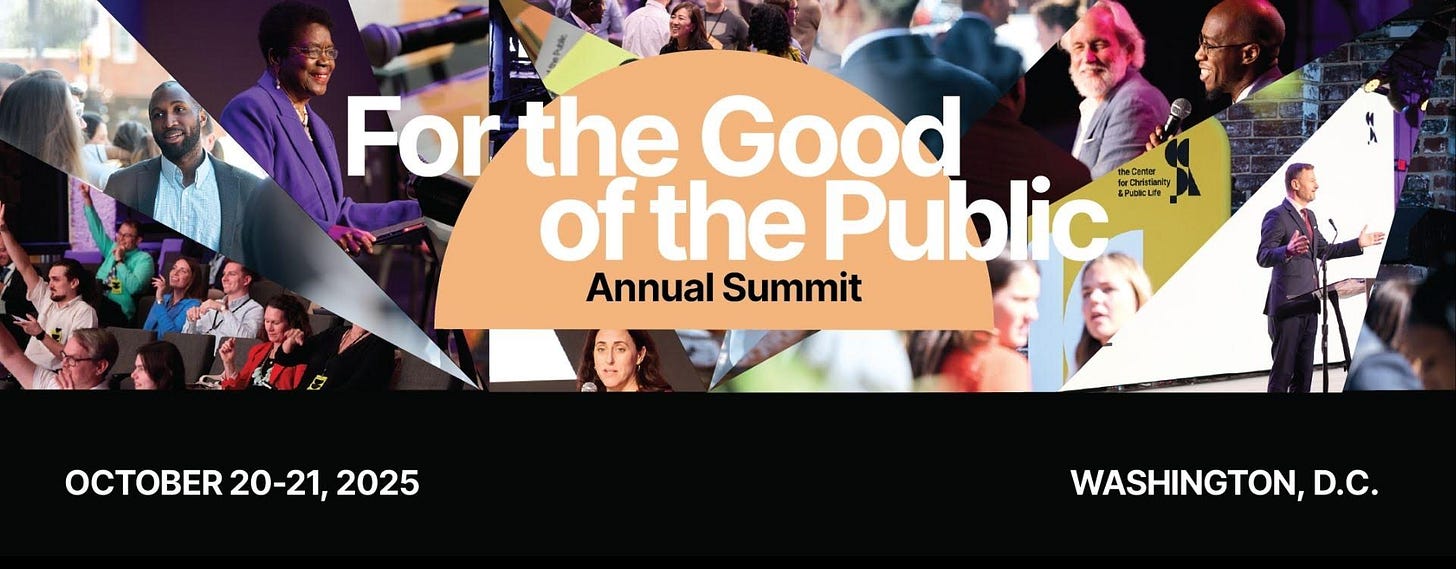

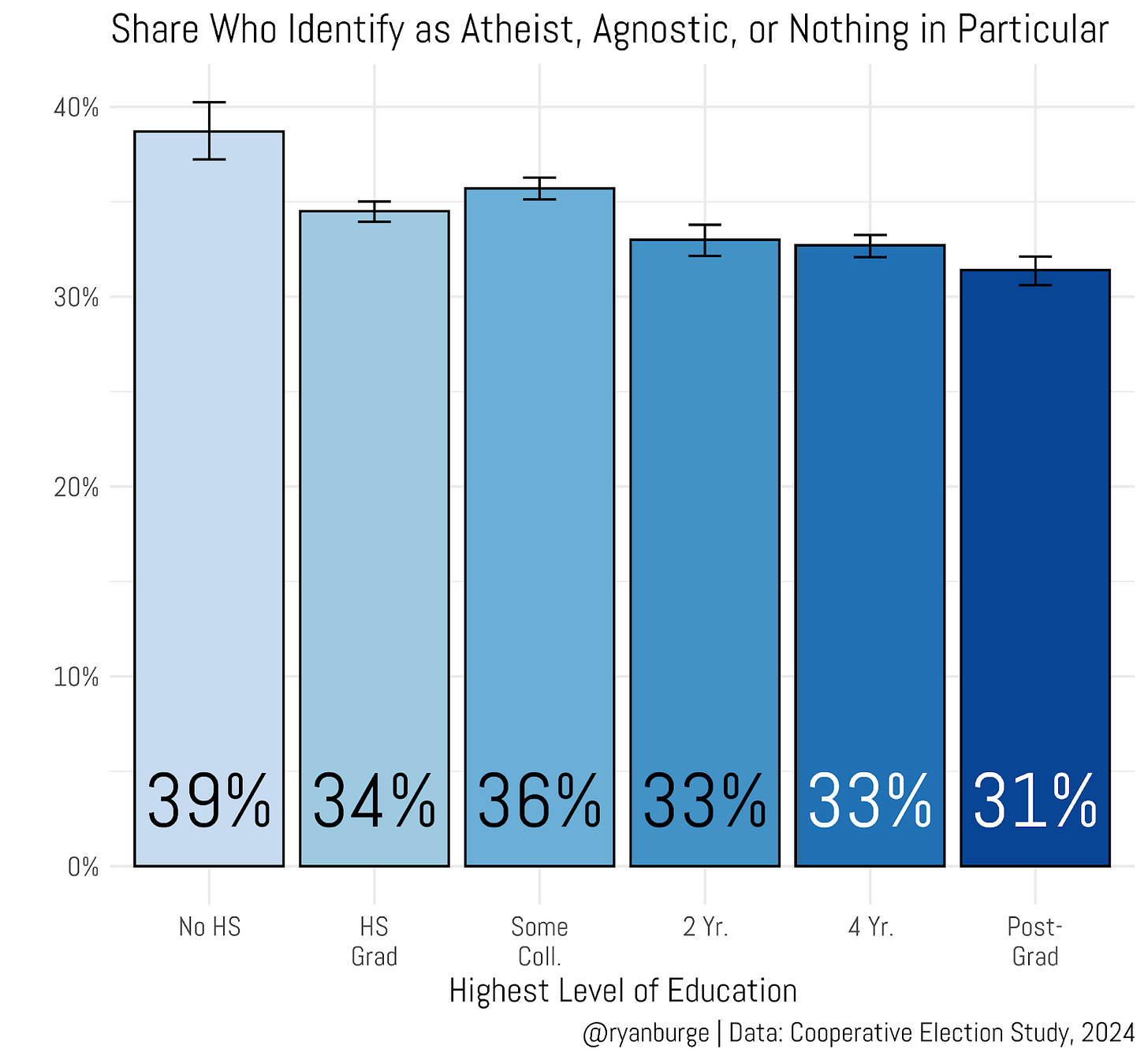
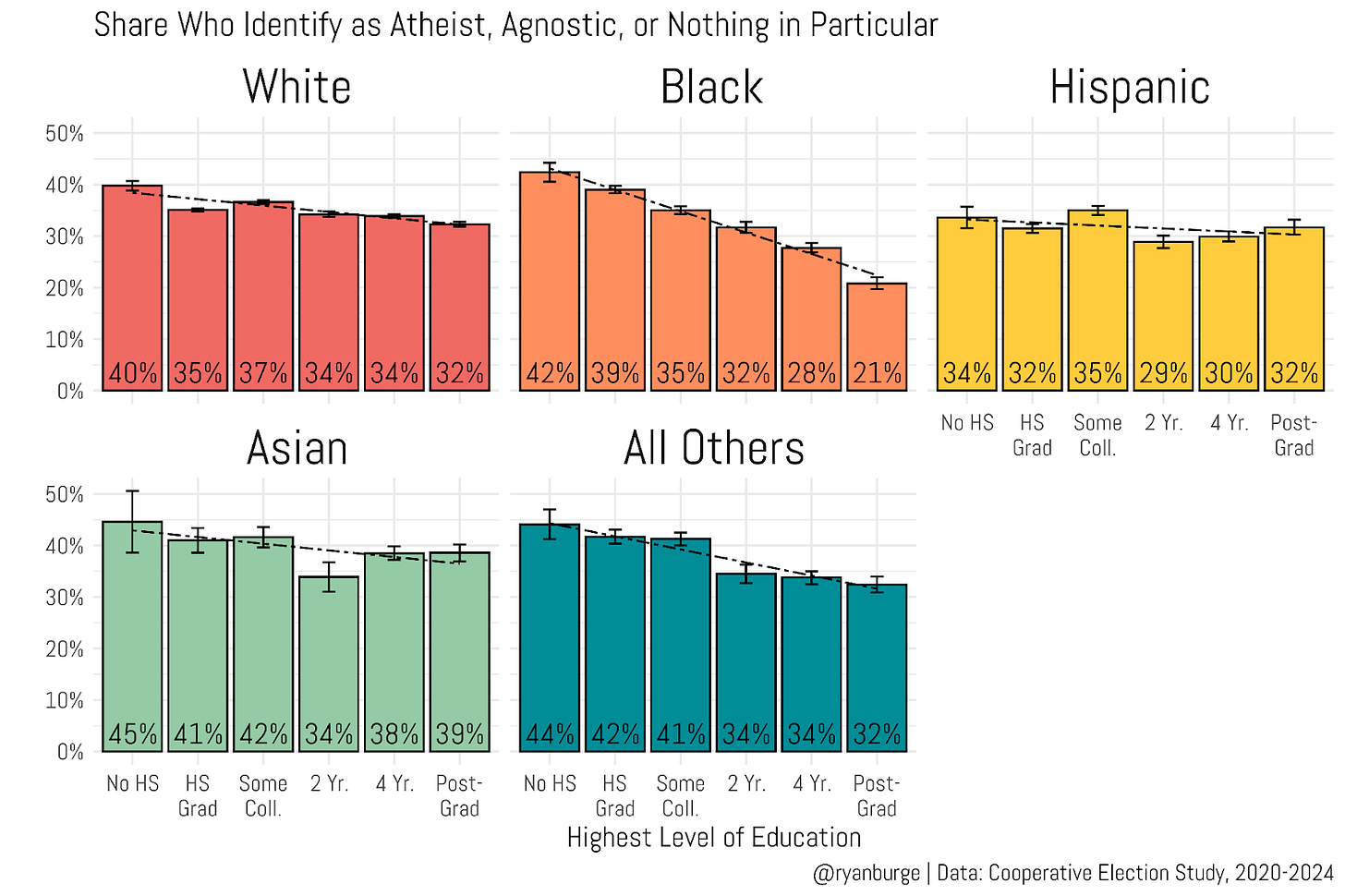

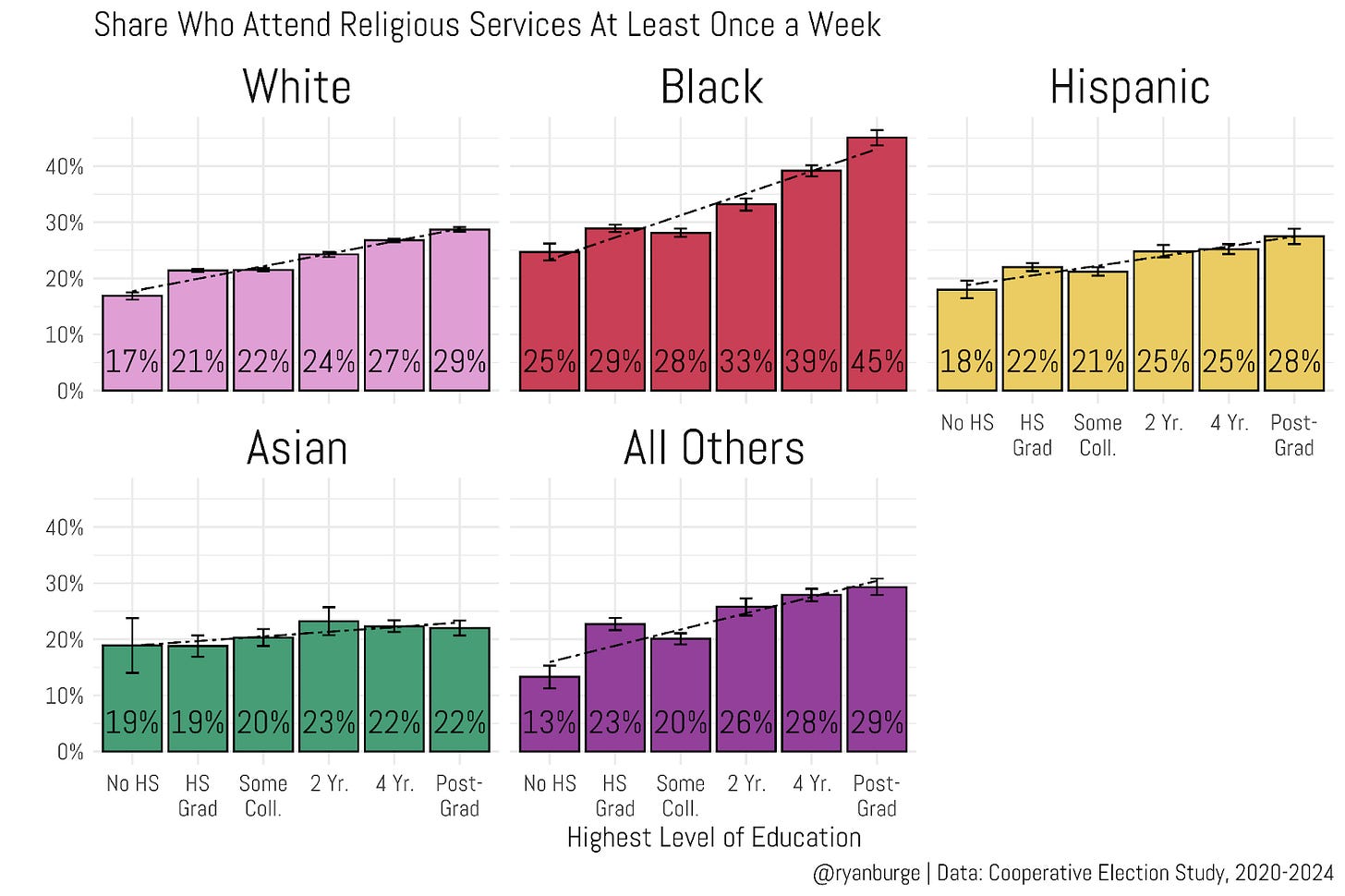
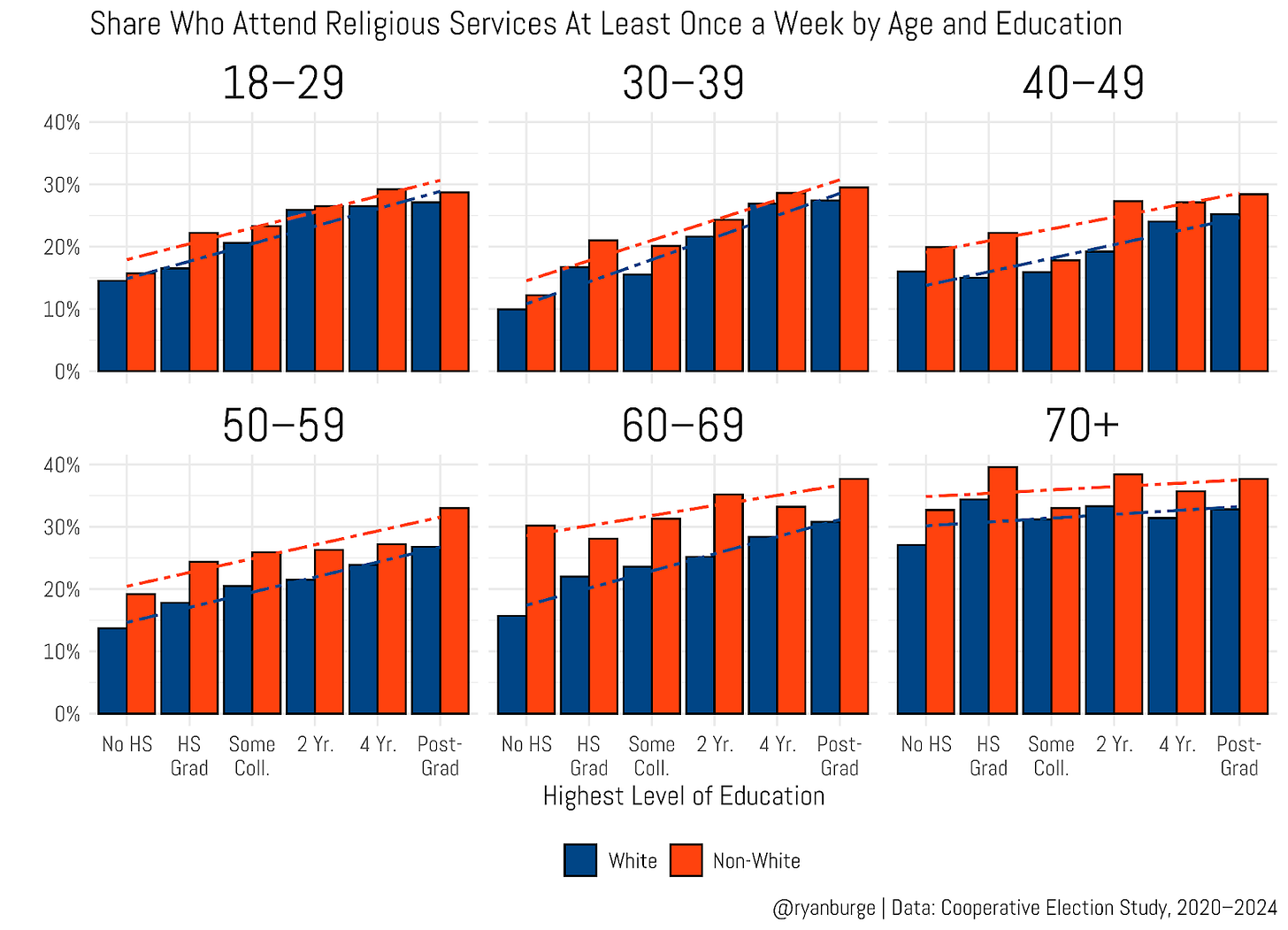
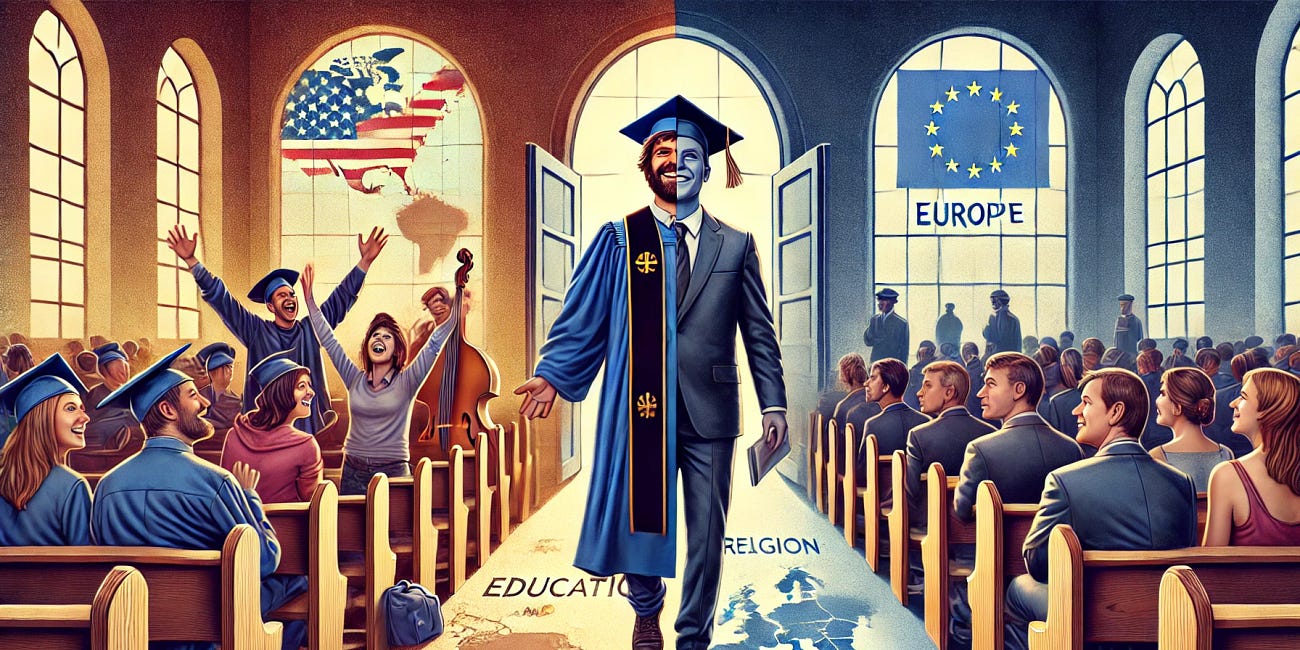
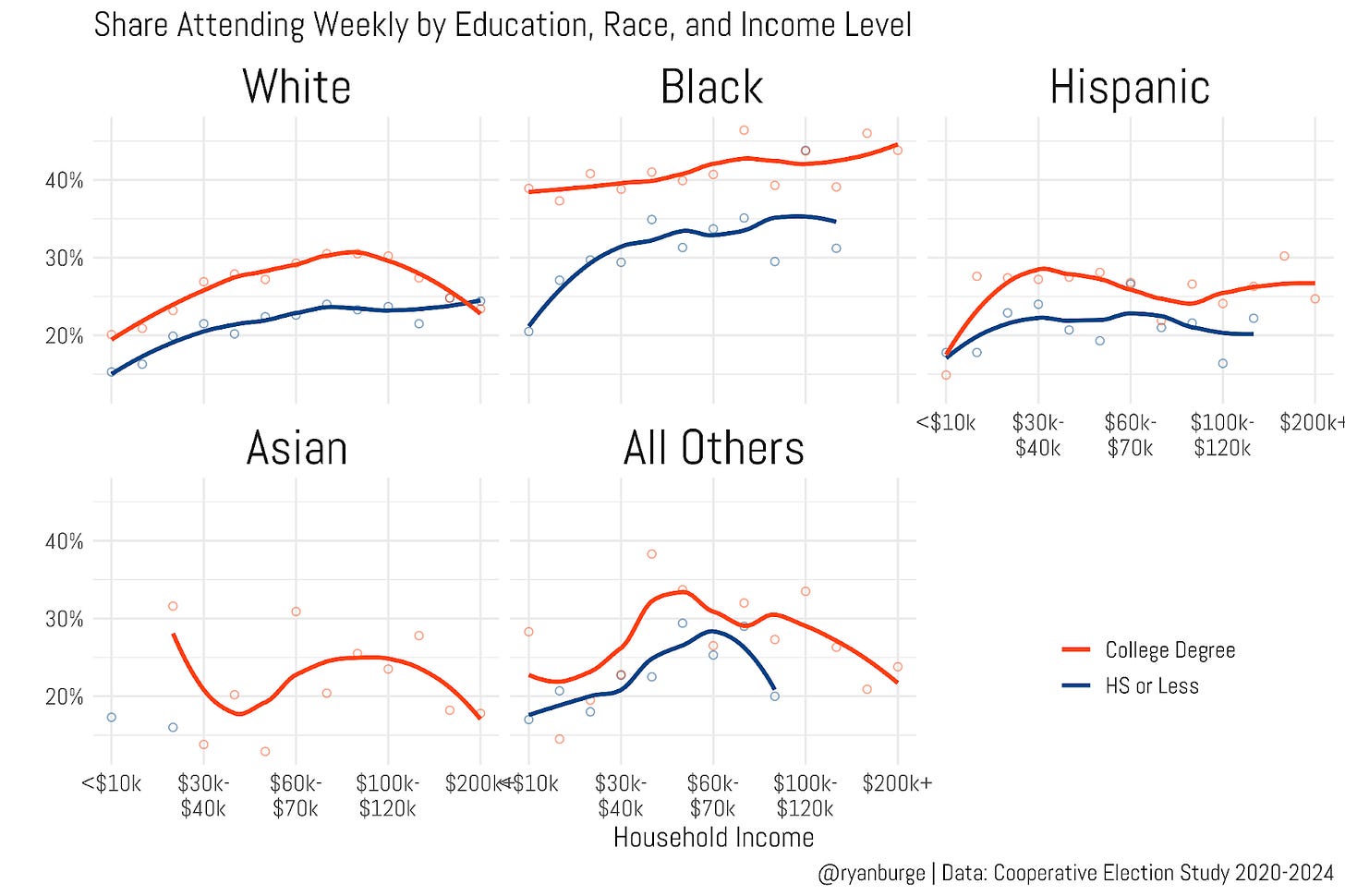

I think that last bit of analysis was extra telling. I think it dovetails Hank Green's razor: "Anything that could possibly be influenced by socio-economic status, probably is" with your previously stated theory that going to church/being religious is something for already successful people in the US.
I like how you take us on a narrative trip through the possibilities in your pieces like this. Love the twists and turns.